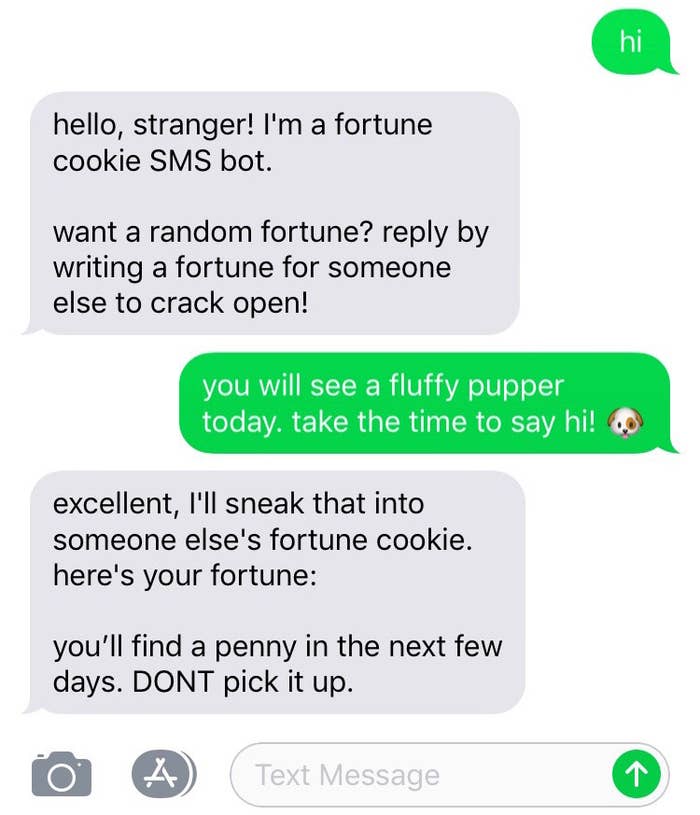I built two simple experiments for mini-interactions between total strangers - a music swap bot and a fortune cookie bot. They are both SMS bots, and the dynamic is simple: the bot provides a prompt, you provide a response, and the bot gives you a response from a total stranger in return.

Try it out!
Random Fortune Cookie
1-530-212-6073
Journalists regularly re-broadcast audience responses - think of a radio call-in show, or featured letters to the editor. Journalists also use crowdsourcing to gather tips or comments. These bots are experiments in simultaneously sharing and collecting first hand responses from an audience, in a way that’s dynamic and playful. Rather than a one way exchange between a journalist and their audience - what does it look like to connect members of an audience to each other?
These bots are a result of several rounds of iteration. Here are some design goals that guided my thinking, as well as some lessons I’ve learned:
Choosing topic that’s personal, but still playful
During my fellowship, one of my goals was to address algorithmic filter bubbles. When people talk about filter bubbles, it’s easy to jump to political filter bubbles because they are salient. However, explicit discussions around politics can come with a lot of baggage: preconceptions, assumptions, and a general air of defensiveness.
Instead of jumping right into politics, it’s worthwhile to start by connecting people on aspects of culture and identity (which are undoubtedly intertwined with one’s politics). My goal was to choose topics that are personal and cultural while still being playful, so that people can let their guard down - music and silly fortunes fit the bill.
Exploring the grey area between private and public
There are digital spaces where your writing is visible to everyone (e.g. twitter, comment sections), spaces visible only to you (e.g. dropbox, drive), and spaces visible to specified recipients (e.g. email, chat). Because these spaces have different audiences, we use them in very different ways and feel different levels of freedom. I wanted to design a space that’s neither fully private nor fully public, and see how people navigate it.
If you know it’s possible for someone to see your response, but don’t know who or when - how does that change the nature of what you type into a text box?
Avoiding potential creepiness
Since I wanted to keep these experiments playful, I chose to design very light interactions over sustained conversations. After all, coming into contact with strangers carries risk, and can easily turn creepy or unsafe. Instead of connecting people directly, I aimed to mediate connection and disable the ability to respond and chat further. The only feedback loop I incorporated was a notification once your response has been delivered.
Built-in moderation
These projects haven’t actually encountered abusive or creepy responses - I suspect because there isn’t instant gratification for abuse. Usually, when an online troll posts a hateful comment or a hateful tweet, there’s the instant “reward” of seeing their text public or knowing that their target will get a notification. Since the responses on my SMS bots aren’t fully public - people have the ability to see your response, but you don’t know who or when - it really isn’t much fun for trolls.
That being said, it’s still useful to build in moderation for responses. I have an admin page (behind a login, of course) where I can filter out any responses that shouldn’t be seen. In practice, the “inappropriate” content usually just turns out to be people who sent in dummy responses (e.g. “test”) that wouldn’t be interesting to surface to others. Moderation serves the purpose of quality control.
Embracing the low-tech
These projects don’t involve any cutting edge technology. I chose SMS as a medium because it’s accessible and easy to engage with - the only equipment it requires is a phone. I also kept the bot interactions as “dumb” as possible, without multiple conversation trees and without additional complexity.
By spending less energy on the technology, I had more time to experiment with conversation design, topics, and tone - aspects that ultimately have high impact on whether people want to engage with a project.
Embracing randomness
One approach to popping algorithmic bubbles is to actively identify things that are outside one’s interests - for example, finding news sources that are most different from the news sources you frequent, or finding music that’s most “different” from what you like. However, I explicitly chose not to take this approach, because it’s a form of personalization in itself - codifying what “difference” means in an algorithm is as tricky and fraught as writing a personalization algorithm. Moreover, this approach implicitly encourages an adversarial framing, which can be unhealthy and counterproductive.
Instead, I took the much simpler approach of leveraging randomness. When you text a song to the music swap bot, the bot randomly selects a song from the responses it receives - each response has equal chance of being seen. Randomness has its perks: it’s unpredictable, it encourages serendipity, and it largely avoids making assumptions about what content someone “should” see.
These projects are open source and live on the Open Lab GitHub - check them out, and adapt them as you please.
